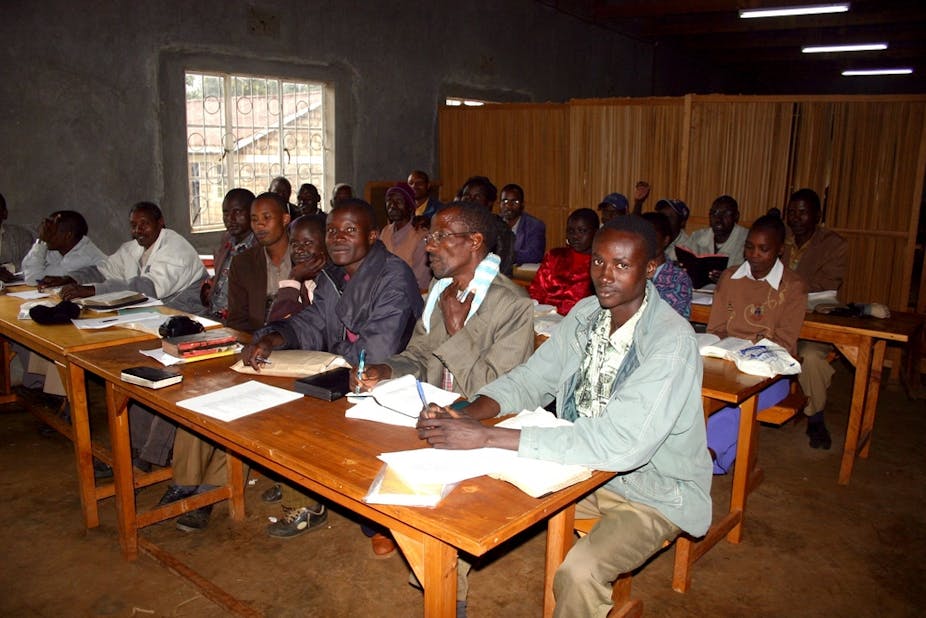More and more universities are using part-time lecturers rather than employing full-time faculty members. In the US, for instance, it’s estimated that about 50% of university teachers are only employed on a part-time basis.
A recent study found that just 35% of these adjunct scholars would like to become full-time teachers. Many have other positions beyond universities and enjoy the part-time nature of their academic work.
Part-timers make up 80% of teachers at Latin American universities. Brazil is the only exception to the rule in this region.
In Kenya around 50% of country’s public university lecturers are engaged in part-time teaching.
Kenya wants to reverse this, and buck the global trend. The cabinet secretary for education recently announced that part-time lecturers would be phased out at the country’s universities by 2018.
This is part of an attempt by Kenyan authorities to improve the quality of university education. But the government, and universities, must be careful not to throw the proverbial baby out with the bathwater. Some adjunct academics bring vast experience from the working world beyond universities’ ivory towers. Their skills must not be lost.
Saving money, compromising quality
Money is tight for higher education in Kenya, as it is elsewhere in Africa. Universities save money by hiring part-time academics. These workers don’t qualify for benefits and are not paid full salaries. Many juggle several jobs to make ends meet. Typically, a part-time lecturer at a public university earns an average of US $360 a month. The average salary for the most junior full-time faculty members is US $1,300 a month.
The status quo is taking its toll. Some part-time academics have questionable qualifications. Many are spread so thinly between institutions that they cannot possibly teach well. These academics bounce between private and public institutions, moving back and forth day after day to teach in different places.
The emergence of part-time university lecturers in Kenya can be traced to the early 1990s. This is when private universities were first authorised to operate. The government agreed that, to cushion these newcomers against financial problems, only 50% of their teaching staff needed to be full-time employees. Many of their temporary staff were drawn from public universities.
Then, in the late 1990s, public universities started to expand rapidly. More students were admitted, and the numbers rose from around 21,846 two decades ago to more than 440,000 currently. Many public institutions opened branch campuses. These were often staffed by part-time academics.
This led to the current situation in which around half of Kenya’s public university lecturers are engaged in part-time teaching.
One of the other problems is that part-time lecturers tend only to be teachers. They don’t get involved in other university work like research, committee meetings and advising postgraduate students. They are also not loyal to one institution; they know little or nothing about an individual university’s missions, policies, procedures and programmes.
Of course, not all part-time lecturers are poor teachers. Research has found that those with prior full-time teaching experience have much to offer universities. This group tends not to be taking on many piecemeal part-time appointments, and so are not thinly spread or rushing from campus to campus.
Potential solutions
The government’s move to phase out part-time lecturers was announced early in September 2016. By 2018, the Commission for University Education wants all lecturers to hold PhDs – a move that would lock out many part-timers, who hold lower degrees.
Some universities have already taken decisive action to deal with criticisms about their dependence on part-time lecturers. Mount Kenya University, a private institution, recently fired 2,900 part-time lecturers and replaced them with 100 full-time lecturers, all of whom have PhDs.
A few public universities have decided to close down their branch campuses rather than bringing in more part-timers to bulk up teaching staff at these sites.
However Kenya’s universities choose to respond to the government’s decree, they must be careful not to shut part-time academics out entirely. Universities are often criticised for producing graduates who have no practical understanding or experience. To avoid doing this, they must hire experienced experts in professional and technical disciplines – architecture, engineering, law and medicine – as adjunct lecturers-of-practice who will bring real world work experiences into the classroom.
Kenya’s higher education sector shouldn’t be built entirely on the backs of part-time lecturers. But those adjunct academics who are qualified and competent must not be totally disregarded if universities are to boost their quality and cater for a growing student population.

